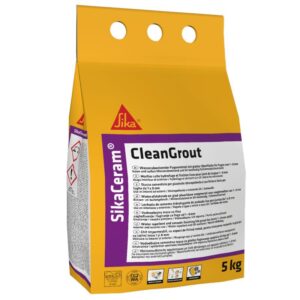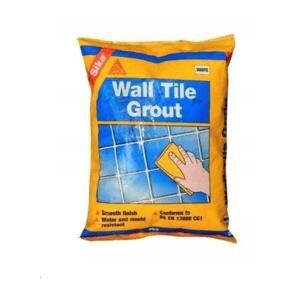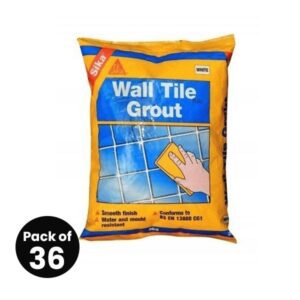What is tile grout?
Simply put, grout is a fluid, gooey mixture most commonly used in tiling to fill the space between glass, ceramic and stone tiles. Since hard tiles such as porcelain, ceramic, marble and stone tend to naturally contract and expand with the fluctuation of external factors such as temperature, placing the individual tiles immediately next to each other will unavoidably result in chips and cracks. To preserve the look and integrity of the tiles, grout is used as a buffer in the areas between them – it not only prevents wear, but also keeps bacteria and moisture from slipping between the tiles and into the layers beneath the surface.
In its most basic form, grout is rather porous and therefore likely to stain. The best way to reduce the likelihood of grout stains is by investing in newer grout formulas, and applying grout sealer after tiling has been completed. That being said, the most efficient way to keep tile grout from staining is by wiping up surfaces immediately after spills occur.
What are the types of tile grout?
Commonly, grout comes in two types – epoxy-based and cement-based, depending on the particular nature of the building project. The aptly named cement-based grout, such as the SikaGrout 211, is a mix of Portland cement, pigments and water, and in its basic ‘non-sanded’ formula is used on spaces 1/8th of an inch on narrower. For filling larger gaps, sand is added to the mixture to create sanded tile grout, which is less likely to shrink and boasts a stronger hold.
Epoxy-based grout, on the other hand, contains a mixture of hardener and resin. Compared with its cement counterpart, epoxy grout is best known for being waterproof and resistant, as well as for having a longer shelf life (in fact, provided it’s stored at the right temperature, a container of epoxy grout will last you indefinitely). This type of grout does not require additional setting and is best suited for areas where tiles might be exposed to water, grease or chemicals. Similarly to cement-based grout, it can be both sanded and non-sanded.
Alternatively, grout is also known to have structural and civil engineering applications. Structural grout tends to be particularly strong, as it is used to secure reinforced steel and bond it to surrounding masonry. This type of grout is also great at withstanding vibration and is resistant to shrinking. In civil engineering, grout is injected into soil or rock formations with the purpose of altering their permeability.
Which is the best type of tile grout?
Since both epoxy-based and cement-based grouts are able to provide quality protection to your tiled walls and floors, which one you opt for comes down to a mixture of personal preference and the circumstances of your project.
If the main factor is the ease with which the grout can be shaped during application, so that it’s optimally useful for grouting round edges, curves and corners, cement grout is the best choice. However, if you need grout for areas such as bathroom or kitchen, where there would likely be lots of water, it might not be a great option, since it can be quite porous.
For such spaces where cement grout would fail, the water and stain resistant epoxy grout is a fantastic alternative. However, a possible downside to this type of grout could be the fact that it’s harder to apply as there’s only a limited amount of time during which it is workable before it sets. The rubbery look of epoxy grout might also not be suited to everyone’s taste.
Should you use sanded or non-sanded tile grout?
As discussed, non-sanded grout is the right choice for the grouting of smaller tile joints, as it allows for greater precision. Due to its increased solidity when compared to sanded grout, it’s also better suited for tiling work on vertical surfaces. However, attempting to fill wider joints with non-sanded grout could lead to cracks.
Generally used for larger joints, sanded grout is a great alternative for heavier tile materials such as natural stone, glass, or marble. It is worth noting, however, when working with polished tiles, sanded grout might create scratches on the surface, so it’s advisable to test on a smaller area first to avoid damaging the flooring.
What is the difference between tile grout and mortar?
Generally speaking, grout and mortar are quite similar, as they are both hardening, cement-based products. The main difference between the two is that grout has a greater water concentration and is more flexible, meaning it is better suited for filling complex, small or inaccessible gaps.
Despite the fact that grout helps keep tiles in place, it does not have adhesive properties; ensuring the tiles are properly stuck to the surfaces of walls or floors is mortar’s role. Once the mortar has cured, grout is used to fill in the spaces between the tiles.
How to choose tile grout colour?
The two main options to choose from when selecting grout colour are complementary and contrasting. For a uniform, monolithic installation that draws the eye towards the surface of individual tiles, opt for a grout colour to blend with the tiling (e.g. blue grout for a blue backsplash). You could also thread the middle ground with a neutral colour, such as a shade of white or grey, which is always a reasonably safe choice.
On the other hand, if your goal is to emphasise pattern and shape, choose a grout colour dramatically different from that of your tiles – the best example being combining black tile with white grout or vice versa. As a general rule, if you’ve chosen this option it is advisable that you grout a sample section and spend a few days living with it to make sure it’s the right choice.
Sika tile grouts are currently offered in one variety only:
SikaCeram Wall Tile Grout
SikaCeram Wall Tile Grout is a powdered cement based, polymer modified joint filling compound for joints up to 3mm wide, which complies to BS EN 13888 and BS EN 12004 Type CG1. Suitable for internal and external locations and contains a built in biocide to protect against black spot mould growth.




